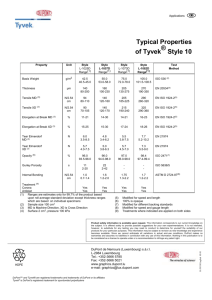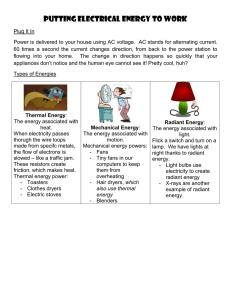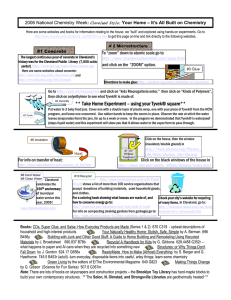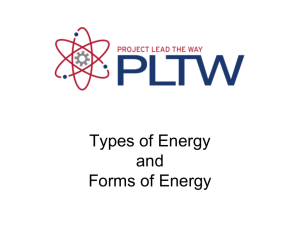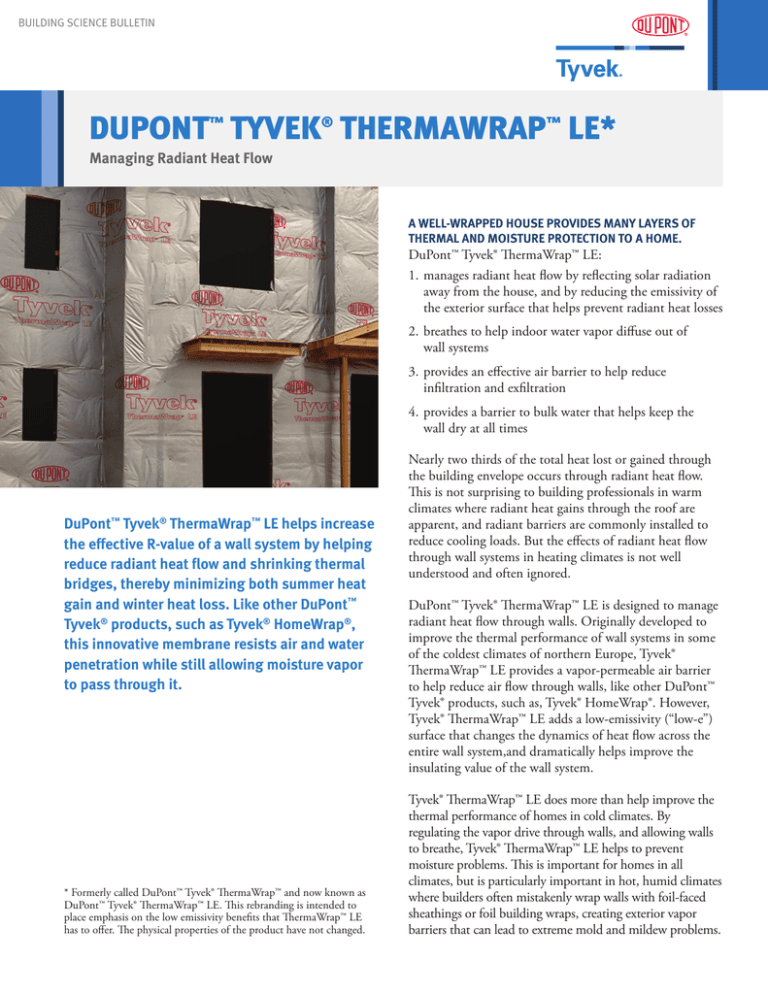
BUILDING SCIENCE BULLETIN
DUPONT™ TYVEK® THERMAWRAP™ LE*
Managing Radiant Heat Flow
A WELL-WRAPPED HOUSE PROVIDES MANY LAYERS OF
THERMAL AND MOISTURE PROTECTION TO A HOME.
DuPont™ Tyvek® ThermaWrap™ LE:
1.manages radiant heat flow by reflecting solar radiation
away from the house, and by reducing the emissivity of
the exterior surface that helps prevent radiant heat losses
2.breathes to help indoor water vapor diffuse out of
wall systems
3.provides an effective air barrier to help reduce
infiltration and exfiltration
4.provides a barrier to bulk water that helps keep the
wall dry at all times
DuPont™ Tyvek® ThermaWrap™ LE helps increase
the effective R-value of a wall system by helping
reduce radiant heat flow and shrinking thermal
bridges, thereby minimizing both summer heat
gain and winter heat loss. Like other DuPont™
Tyvek® products, such as Tyvek® HomeWrap®,
this innovative membrane resists air and water
penetration while still allowing moisture vapor
to pass through it.
* Formerly called DuPont™ Tyvek® ThermaWrap™ and now known as
DuPont™ Tyvek® ThermaWrap™ LE. This rebranding is intended to
place emphasis on the low emissivity benefits that ThermaWrap™ LE
has to offer. The physical properties of the product have not changed.
Nearly two thirds of the total heat lost or gained through
the building envelope occurs through radiant heat flow.
This is not surprising to building professionals in warm
climates where radiant heat gains through the roof are
apparent, and radiant barriers are commonly installed to
reduce cooling loads. But the effects of radiant heat flow
through wall systems in heating climates is not well
understood and often ignored.
DuPont™ Tyvek® ThermaWrap™ LE is designed to manage
radiant heat flow through walls. Originally developed to
improve the thermal performance of wall systems in some
of the coldest climates of northern Europe, Tyvek®
ThermaWrap™ LE provides a vapor-permeable air barrier
to help reduce air flow through walls, like other DuPont™
Tyvek® products, such as, Tyvek® HomeWrap®. However,
Tyvek® ThermaWrap™ LE adds a low-emissivity (“low-e”)
surface that changes the dynamics of heat flow across the
entire wall system,and dramatically helps improve the
insulating value of the wall system.
Tyvek® ThermaWrap™ LE does more than help improve the
thermal performance of homes in cold climates. By
regulating the vapor drive through walls, and allowing walls
to breathe, Tyvek® ThermaWrap™ LE helps to prevent
moisture problems. This is important for homes in all
climates, but is particularly important in hot, humid climates
where builders often mistakenly wrap walls with foil-faced
sheathings or foil building wraps, creating exterior vapor
barriers that can lead to extreme mold and mildew problems.
DUPONT™ TYVEK® THERMAWRAP™ LE ADDS
EFFECTIVE R-VALUE TO WALL ASSEMBLIES
To understand how Tyvek® ThermaWrap™ LE works, it’s
important to first understand the three scientific principles
– conduction, convection and radiation – that describe the
way heat moves through a wall.
Tyvek® ThermaWrap™ LE adds
a low-emissivity surface to the
exterior that helps protect
against conductive heat loss
from thermal bridges at studs
and wall plates
The metalized surface of Tyvek®
ThermaWrap™ LE facing a 3/4 in. air
space adds an effective R-2 thermal
resistance to a wall assembly
The reflective
metalized surface
bounces solar
radiation away from
the wall framing,
reducing summer
heat gain
Taped seams help
prevent air
infiltration and
exfiltration
-convective losses
that carry away
conditioned air and
introduce moisture
Air coming
through weep
holes rises by
convection
venting the
wall cavity
Tyvek® ThermaWrap™ LE
has a high permeability,
which allows water vapor
to escape from within the
wall structure
Sorting Out Heat Transfer In any wall system in any
climate, heat always moves from warmer areas to colder
areas, and the greater the temperature difference between
inside and outside (often referred to as a temperature
gradient), the faster the heat flows. This heat flows through
a wall in three ways – by conduction, by convection and
by radiation. All three of these heat transfer mechanisms
are active in every wall system.
Conduction In a typical cavity wall, mass insulation is
installed to reduce heat flow by conduction – the transfer
of energy directly through a material from molecule to
molecule. However, not all of the heat is stopped.
Depending on the amount of insulation, more or less heat
will conduct through the insulation itself, and an even
greater amount of heat will conduct through the studs and
wall plates where there is little or no insulation.
Convection Heat also flows by convection – the transfer
of heat by air movement. Stopping air flow through the
wall is a key reasons we wrap houses with DuPont™
Tyvek®. By stopping air flow, we stop the leakage of heated
air (and moisture in the form of vapor that is carried by
warm air) and the infiltration of cold air.
Radiation Heat also moves through the wall by radiation,
but this mechanism is often the least well understood
method of heat transfer, and it is typically ignored when
building a wall. But there’s nothing mysterious about it.
Radiant heat flow is transferred from a warmer body to a
cooler body on electromagnetic waves. These waves do not
need to flow through air, and do not need direct contact
between objects. Radiant heat crosses empty space from a
glowing, hot object to a cooler object at a distance. We
know the effects of radiant heat flow all too well: It is
precisely how the sun warms the earth. The sun is a
glowing, radiant object, which emits energy to our bodies
across space. The sun can warm us even if
there is wind; it is not affected by air, or
by the millions of miles of cold empty
space between the sun and the earth
where no air exists at all.
Tyvek® ThermaWrap™ LE breathes, allowing
walls to dry without creating an exterior
vapor barrier. Having a wall that can dry out
is essential for every home, but particularly
critical in extreme climates such as the hot,
humid Gulf coast, where walls covered with
foil-faced products are prone to rot.
The concept of a glowing body radiating energy is
important to keep in mind when we evaluate heat flow
through a wall. In a wall, the “glowing object” – or radiant
body – we want to focus on is the wall assembly, and
particularly the outer surface at the exterior sheathing.
THREE MECHANISMS AT WORK
In a cold climate, heat conducts through the wall from inside
to outside, flowing faster at the studs and wall plates and
slower, but still moving, through the cavity insulation. This
heat warms the exterior sheathing. If housewrap and siding
are installed directly over the sheathing, this heat continues
to conduct through these materials, as well. In essence, the
exterior of the wall becomes a radiant body that releases
energy into the space around the home. In most cases,
however, the heat is whisked off the exterior by convection,
as wind currents blow across the face of the wall.
In any wall system with a gap between the wall structure
and the siding, as with brick veneer or any type of rainscreen siding, the exterior sheathing and the house wrap
become the radiant object that releases energy across the
gap. Typically there is a convective current flowing through
this gap (from air entering the weep holes in brick, for
example, and flowing upwards to the eaves) that whisks
away the radiant energy emitted by the wall. Most
building wraps are highly emissive and release this energy
easily. Black paper is the most emissive of all, as it absorbs
radiant heat more readily than other building wraps.
AN INSULATING HOUSEWRAP FOR ALL SEASONS
Summer
The metalized surface reflects
radiant heat away from the
wall, helping to reduce radiant
heat gains and lower
air-conditioning loads
Winter
The low-emissivity surface cuts
down radiant heat flow through
the wall, helping to reduce
conductive heat losses and
lower heating costs
Water vapor from moisture
migrating through the cladding
is whisked away by convective
air currents
Moisture driven through
rain-soaked brick cladding
drains down and out
Increased R-value of wall
system raises sheathing
temperature, reducing the
likelihood of indoor
moisture condensing on the
backside of the wall
sheathing
REDUCING RADIATION
This is where Tyvek® ThermaWrap™ LE comes into play. By
replacing this building wrap with Tyvek® ThermaWrap™ LE
– a low-emissivity membrane – in any wall system with a
gap of at least 3/4-inch between the framing and the
siding, we create an effective thermal resistance (R-value)
equal to R-2. The R-value created by Tyvek®
ThermaWrap™ LE helps to reflect the radiant energy that
has accumulated in the wall sheathing back into the wall
system so it is not released to the exterior. This reduction
in radiant heat flow is particularly important at the studs,
plate lines, rim joists and headers, where conductive heat
flow through the wall is greatest. Not only does this save
energy, but by maintaining a higher sheathing
temperature, Tyvek® ThermaWrap™ LE changes the dew
point in the wall, and helps reduce the risk of
condensation in wall cavities.
PREVENTING MOISTURE PROBLEMS
Tyvek® ThermaWrap™ LE has a very high vapor
permeability (68 perms), which makes it the only highperm reflective membrane available today. Due to its high
vapor permeability and thermal resistance, it provides the
best possible control of condensation in a wall structure,
helping to minimize the risk of mold, mildew and wood
rot. This is especially important to keep in mind in hot,
humid climates, where foil-faced sheathing and other
radiant barriers are often installed on the exterior to reflect
heat away from homes. Aluminum foil is a perfect vapor
barrier, so whenever the vapor drive moves from inside to
the outside – a common occurrence whenever the outside
temperature drops below the indoor temperature – humid
air will become trapped behind the foil. This is a leading
cause of mold and rot in Gulf coast homes.
On the wall, courses of Tyvek® ThermaWrap™ LE are lapped
shingle-style from bottom to top to shed water, while taping
seams ensures an effective air barrier (above left). Best practice is
to seal the joints of Tyvek® ThermaWrap™ LE with DuPont™
Tyvek® Metalized Tape (above right).
This is not likely to happen with Tyvek® ThermaWrap™ LE.
While the face of Tyvek® ThermaWrap™ LE is metalized,
and can reflect heat away from wall surfaces, it retains its
vapor permeability. The walls continue to breathe, and can
dry out under any climate conditions. A high-perm
membrane and a low-e surface: The best of both worlds.
OUR SPECIALIST NETWORK
A national group of highly-trained field representatives is
available to assist customers with their installations. From
the latest updates on building codes to on-site consulting
and training, your local DuPont™ Tyvek® Specialist will
help make sure each installation is done right.
For more information visit us at
www.weatherization.tyvek.com
or call 1-800-44-Tyvek
Copyright © 2014 E. I. du Pont de Nemours and Company. All rights reserved. The DuPont Oval Logo, DuPont™, Tyvek®, and ThermaWrap™ are registered trademarks or trademarks of DuPont or
its affiliates. 4/14 K-27303

